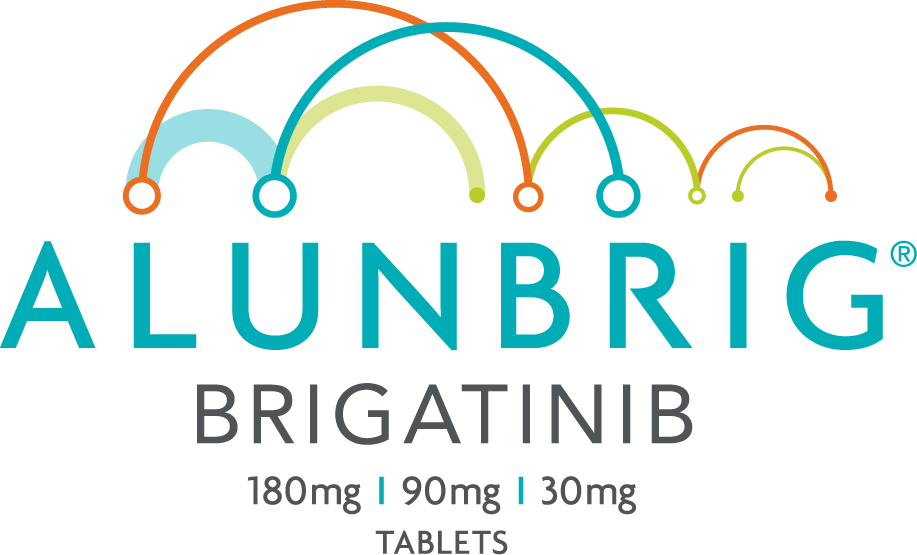How ALUNBRIG® (brigatinib) May Help if You’ve Already Tried Another ALK+ Targeted Treatment

Why Did My Doctor Recommend That I Start a New Treatment?
Unfortunately, despite treatment—even with a targeted therapy—ALK+ non-small cell lung cancer (NSCLC) can still progress (worsen) over time. This may mean that your cancer has developed resistance to your current treatment, and it is no longer working. It's important to know that this may be expected, and you still have options. That’s why your healthcare provider has recommend switching to ALUNBRIG.
Your doctor may also talk to you about switching to ALUNBRIG if, while on your current treatment, you experience side effects you may not be able to tolerate.
ALUNBRIG Was Shown to Shrink Tumors After Crizotinib Treatment in Patients With ALK+ NSCLC Whose Cancer Had Spread to Other Parts of the Body
In a previous ALUNBRIG study, researchers followed 222 patients with ALK+ NSCLC whose cancer had spread to other parts of the body, who had taken the medicine crizotinib, and whose disease had worsened.
112 patients received 90 mg of ALUNBRIG orally once daily (90-mg group).
The other group of 110 patients received the recommended ALUNBRIG dosing regimen of 90 mg orally once daily for 7 days, followed by an increase to 180 mg orally once daily thereafter (90→180-mg group).
Study Results for the Recommended Dosing Regimen (90→180-mg Group)
More than half (53%) of patients achieved a response, meaning their tumors either shrank or disappeared while taking ALUNBRIG.
Overall, 58 out of 110 achieved a response
- 5 out of 110 (4.5%) patients achieved a complete response
- 53 out of 110 (48%) patients achieved a partial response
Additional Study Results
In the same study, 112 patients received 90 mg of ALUNBRIG orally once daily (90-mg group) without having their dose increased.
- 54 out of 112 (48%) patients achieved a response
- 4 out of 112 (3.6%) patients achieved a complete response
- 50 out of 112 (45%) patients achieved a partial response
Responses lasted a median of 13.8 months for both dosing groups.
Additional Second-Line Study Results
ALUNBRIG also showed results in the brain
Study Results for the Recommended Dosing Regimen (90→180-mg Group)
In the same study, 18 patients receiving the recommended dosing regimen had measurable tumors that had spread to the brain.
67% of patients' brain tumors shrank
Nearly 2 out of every 3 patients saw their brain tumors shrink.
- None of the patients had a complete response in the brain
- 67% (12 out of 18) had a partial response in the brain
Of the 12 patients who responded to treatment with ALUNBRIG:
- 6 patients responded for 6 months or longer, and
- 3 patients responded for 12 months or longer
Additional Study Results for the 90-mg Group
26 patients with ALK+ NSCLC in the 90-mg group had measurable tumors that had spread to the brain.
Overall, brain tumors shrank in 11 out of 26 (42%) patients
- 2 out of 26 (7.7%) patients had a complete response in the brain
- 9 out of 26 (35%) patients had a partial response in the brain
Of the 11 patients who responded to treatment with ALUNBRIG:
- 7 patients responded for 6 months or longer, and
- 4 patients responded for 12 months or longer
It's normal to have questions as you begin your treatment on ALUNBRIG.
We have additional resources for you to discuss with your healthcare provider as you get started.
Glossary
- ALK gene - A gene that makes a protein called anaplastic lymphoma kinase or ALK, which is involved in cell growth. Mutated or genetically changed forms of the ALK gene and protein have been found in some types of cancer, such as NSCLC.
- Complete response - The disappearance of tumors in response to a given treatment. This is not the same as a cure.
- Median - The middle number in a set of measurements arranged from lowest to highest.
- Partial response - The decrease in size and spread of tumors in response to a given treatment.
- Resistance - When cancer cells do not respond to a drug used to destroy or weaken them. Drug resistance may happen at the beginning of a treatment or may happen over time.
